Diploma in Early Childhood Education and Care Assignment Help
VerifiedAdded on 2023/04/21
|9
|2711
|402
Report
AI Summary
This assignment provides a comprehensive overview of early childhood education and care, beginning with a personal philosophy statement emphasizing the importance of understanding and respecting natural resources. It details the management structure of an educational facility, including communication strategies and staffing ratios, advocating for one teacher per four children to ensure quality education. The assignment includes a detailed room design and staff scheduling plan, followed by a discussion on the recruitment process for educators, focusing on assessing candidates' abilities and providing ongoing training and supervision. Furthermore, it addresses performance reviews related to program effectiveness, children and families, staff, community, and students, and identifies areas for improvement through training programs and weekly meetings to gather feedback and enhance the overall educational experience. Desklib provides access to this and many other solved assignments.
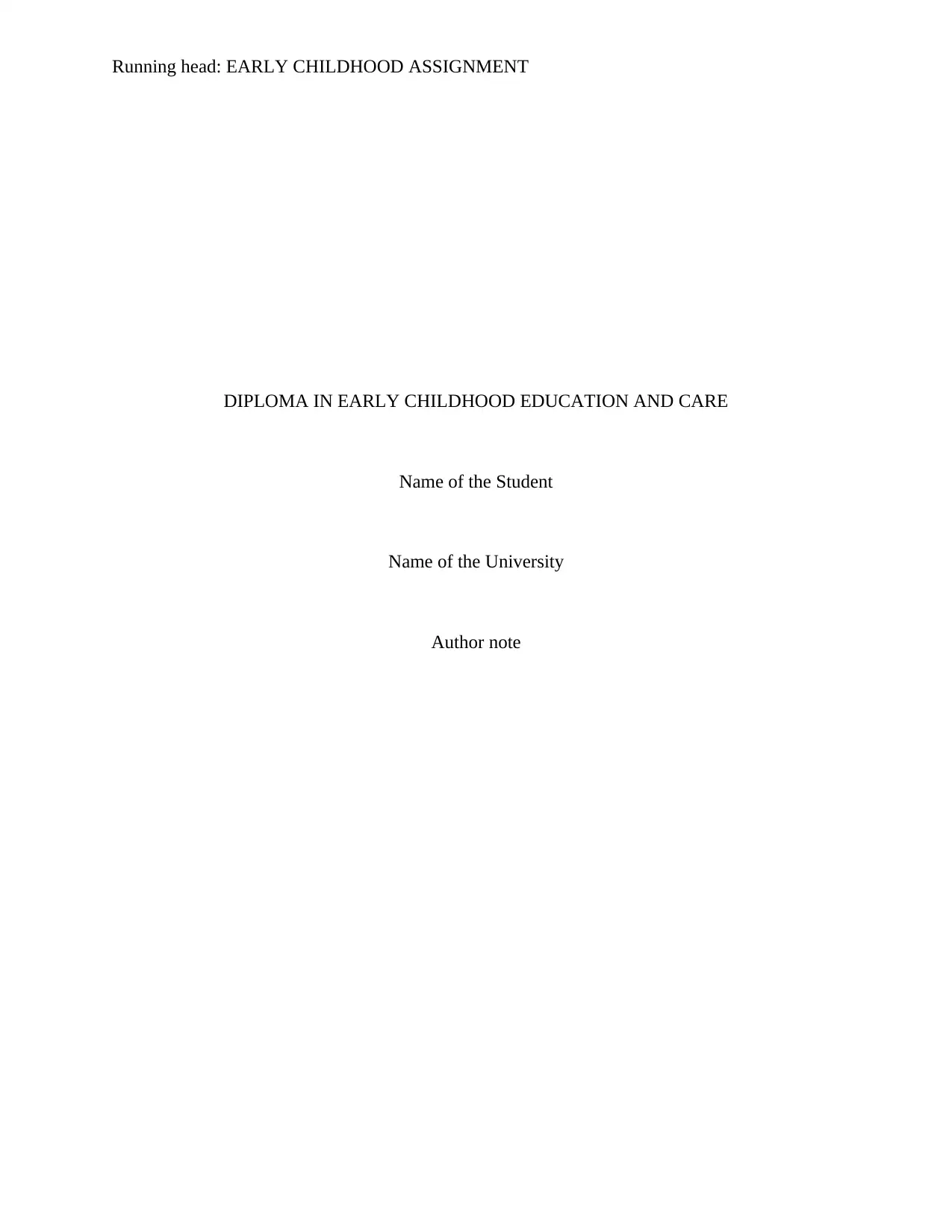
Running head: EARLY CHILDHOOD ASSIGNMENT
DIPLOMA IN EARLY CHILDHOOD EDUCATION AND CARE
Name of the Student
Name of the University
Author note
DIPLOMA IN EARLY CHILDHOOD EDUCATION AND CARE
Name of the Student
Name of the University
Author note
Paraphrase This Document
Need a fresh take? Get an instant paraphrase of this document with our AI Paraphraser
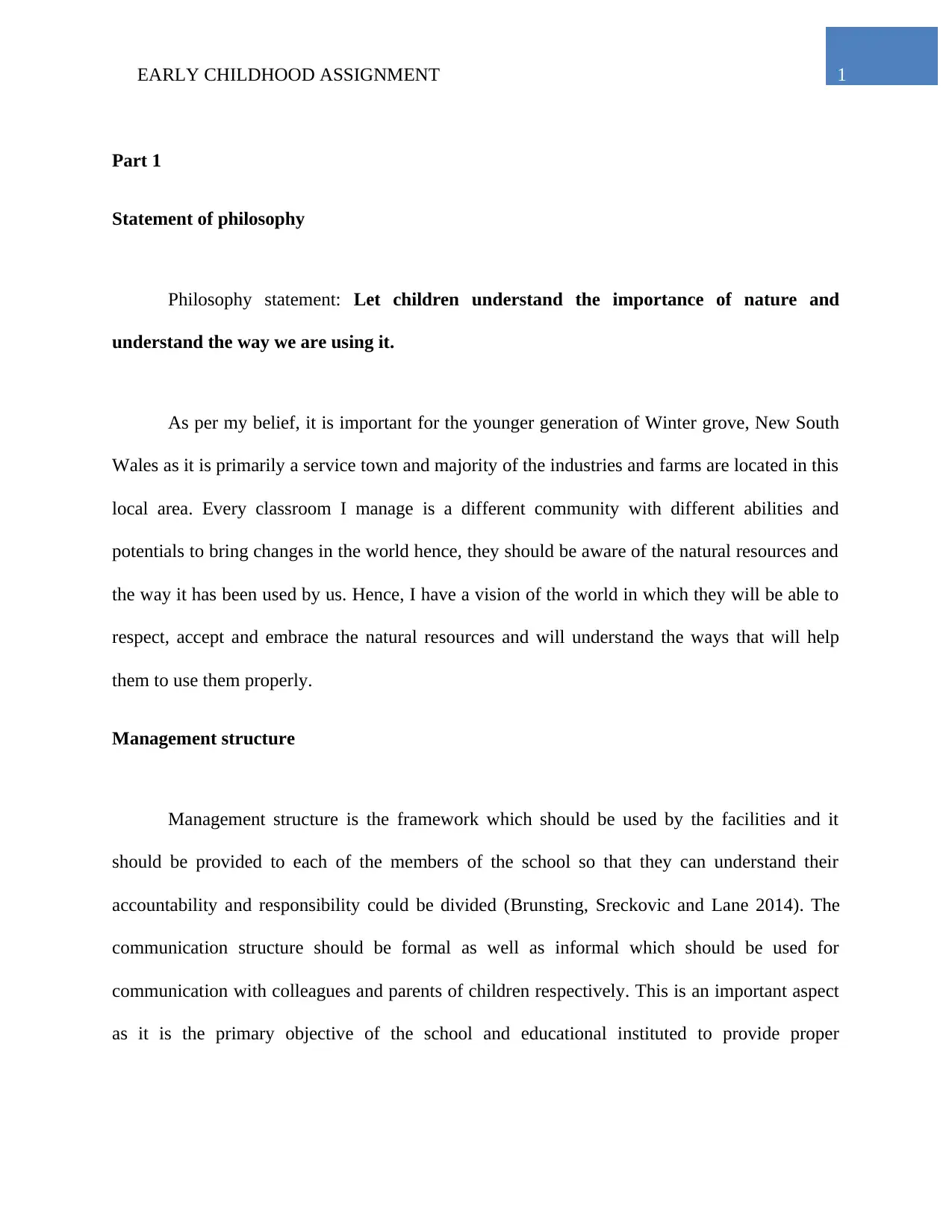
1EARLY CHILDHOOD ASSIGNMENT
Part 1
Statement of philosophy
Philosophy statement: Let children understand the importance of nature and
understand the way we are using it.
As per my belief, it is important for the younger generation of Winter grove, New South
Wales as it is primarily a service town and majority of the industries and farms are located in this
local area. Every classroom I manage is a different community with different abilities and
potentials to bring changes in the world hence, they should be aware of the natural resources and
the way it has been used by us. Hence, I have a vision of the world in which they will be able to
respect, accept and embrace the natural resources and will understand the ways that will help
them to use them properly.
Management structure
Management structure is the framework which should be used by the facilities and it
should be provided to each of the members of the school so that they can understand their
accountability and responsibility could be divided (Brunsting, Sreckovic and Lane 2014). The
communication structure should be formal as well as informal which should be used for
communication with colleagues and parents of children respectively. This is an important aspect
as it is the primary objective of the school and educational instituted to provide proper
Part 1
Statement of philosophy
Philosophy statement: Let children understand the importance of nature and
understand the way we are using it.
As per my belief, it is important for the younger generation of Winter grove, New South
Wales as it is primarily a service town and majority of the industries and farms are located in this
local area. Every classroom I manage is a different community with different abilities and
potentials to bring changes in the world hence, they should be aware of the natural resources and
the way it has been used by us. Hence, I have a vision of the world in which they will be able to
respect, accept and embrace the natural resources and will understand the ways that will help
them to use them properly.
Management structure
Management structure is the framework which should be used by the facilities and it
should be provided to each of the members of the school so that they can understand their
accountability and responsibility could be divided (Brunsting, Sreckovic and Lane 2014). The
communication structure should be formal as well as informal which should be used for
communication with colleagues and parents of children respectively. This is an important aspect
as it is the primary objective of the school and educational instituted to provide proper
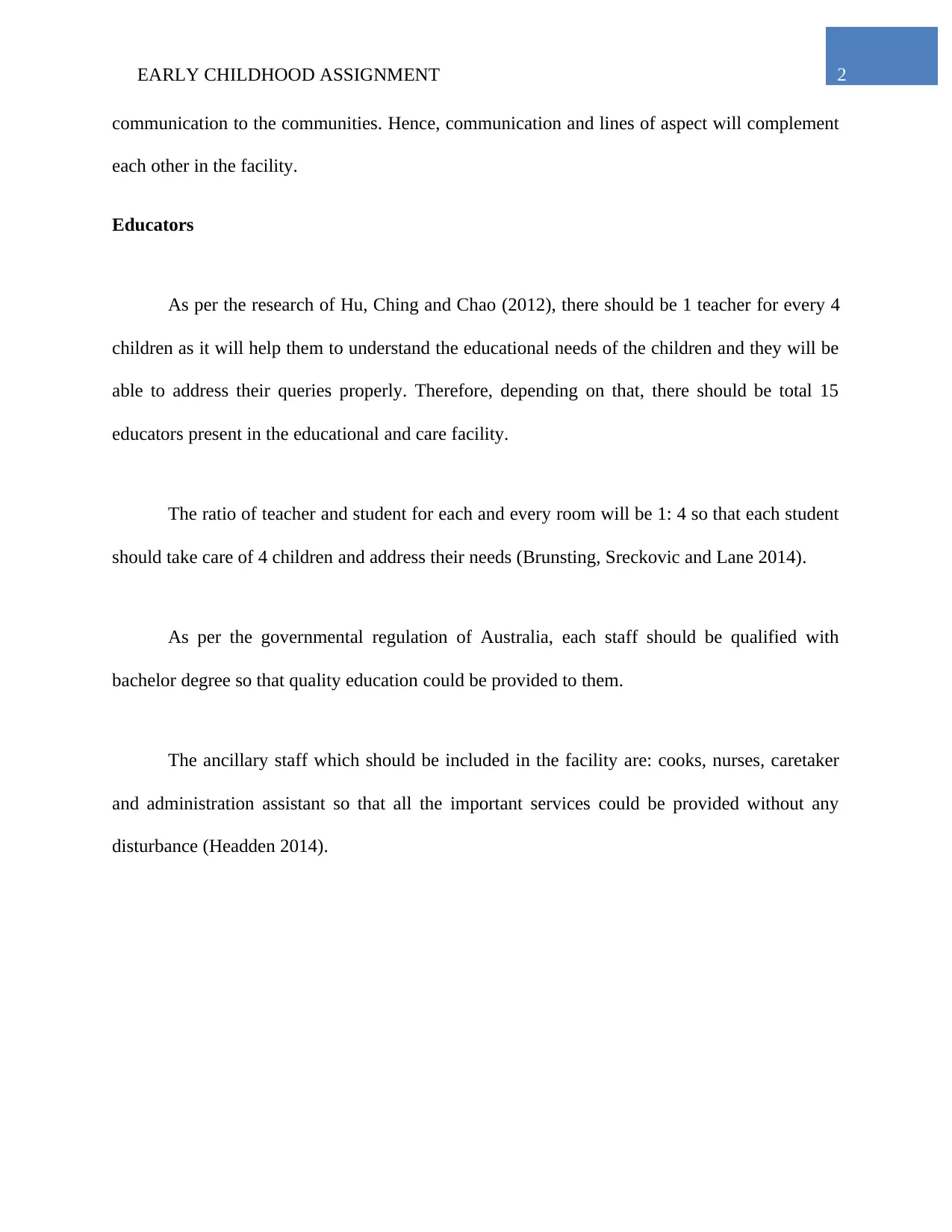
2EARLY CHILDHOOD ASSIGNMENT
communication to the communities. Hence, communication and lines of aspect will complement
each other in the facility.
Educators
As per the research of Hu, Ching and Chao (2012), there should be 1 teacher for every 4
children as it will help them to understand the educational needs of the children and they will be
able to address their queries properly. Therefore, depending on that, there should be total 15
educators present in the educational and care facility.
The ratio of teacher and student for each and every room will be 1: 4 so that each student
should take care of 4 children and address their needs (Brunsting, Sreckovic and Lane 2014).
As per the governmental regulation of Australia, each staff should be qualified with
bachelor degree so that quality education could be provided to them.
The ancillary staff which should be included in the facility are: cooks, nurses, caretaker
and administration assistant so that all the important services could be provided without any
disturbance (Headden 2014).
communication to the communities. Hence, communication and lines of aspect will complement
each other in the facility.
Educators
As per the research of Hu, Ching and Chao (2012), there should be 1 teacher for every 4
children as it will help them to understand the educational needs of the children and they will be
able to address their queries properly. Therefore, depending on that, there should be total 15
educators present in the educational and care facility.
The ratio of teacher and student for each and every room will be 1: 4 so that each student
should take care of 4 children and address their needs (Brunsting, Sreckovic and Lane 2014).
As per the governmental regulation of Australia, each staff should be qualified with
bachelor degree so that quality education could be provided to them.
The ancillary staff which should be included in the facility are: cooks, nurses, caretaker
and administration assistant so that all the important services could be provided without any
disturbance (Headden 2014).
⊘ This is a preview!⊘
Do you want full access?
Subscribe today to unlock all pages.

Trusted by 1+ million students worldwide
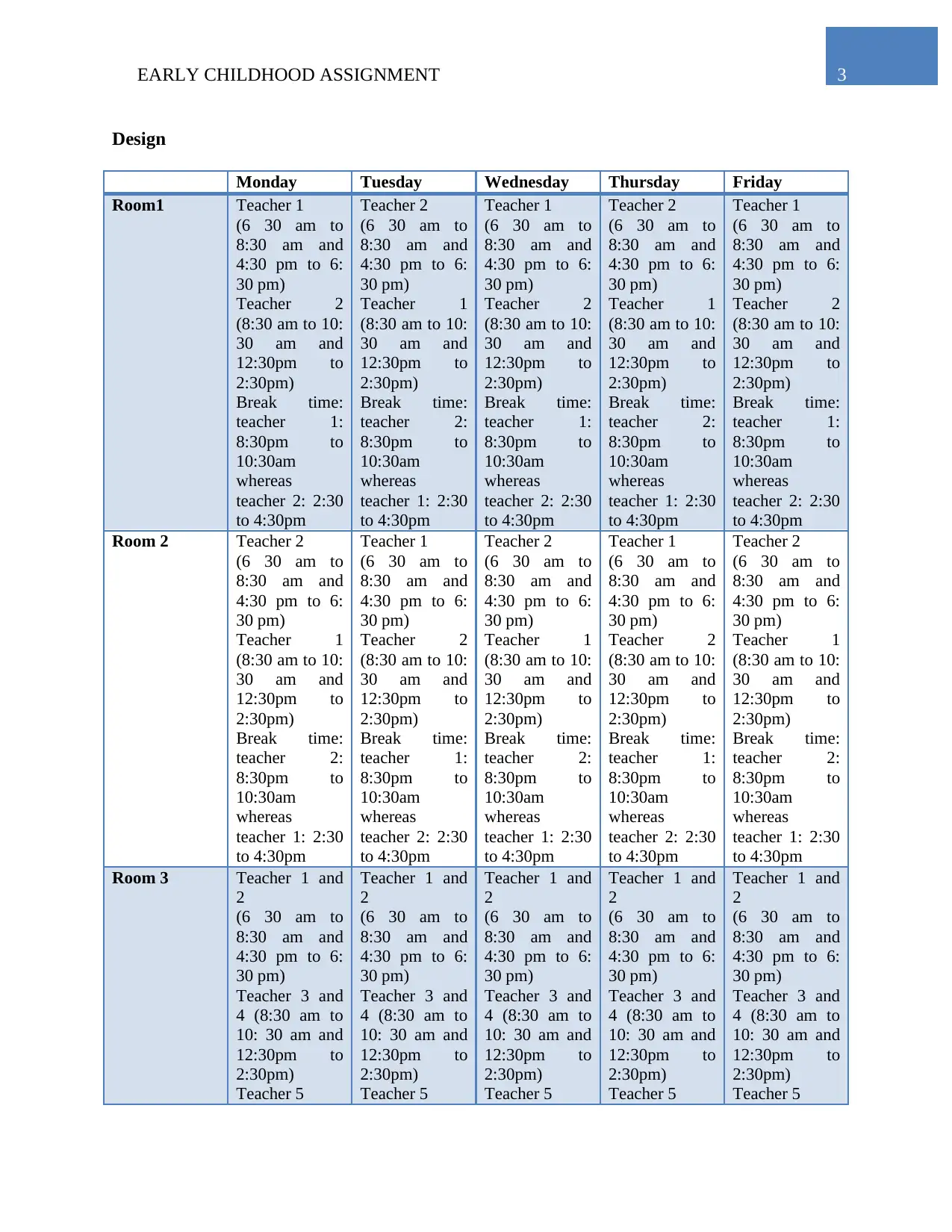
3EARLY CHILDHOOD ASSIGNMENT
Design
Monday Tuesday Wednesday Thursday Friday
Room1 Teacher 1
(6 30 am to
8:30 am and
4:30 pm to 6:
30 pm)
Teacher 2
(8:30 am to 10:
30 am and
12:30pm to
2:30pm)
Break time:
teacher 1:
8:30pm to
10:30am
whereas
teacher 2: 2:30
to 4:30pm
Teacher 2
(6 30 am to
8:30 am and
4:30 pm to 6:
30 pm)
Teacher 1
(8:30 am to 10:
30 am and
12:30pm to
2:30pm)
Break time:
teacher 2:
8:30pm to
10:30am
whereas
teacher 1: 2:30
to 4:30pm
Teacher 1
(6 30 am to
8:30 am and
4:30 pm to 6:
30 pm)
Teacher 2
(8:30 am to 10:
30 am and
12:30pm to
2:30pm)
Break time:
teacher 1:
8:30pm to
10:30am
whereas
teacher 2: 2:30
to 4:30pm
Teacher 2
(6 30 am to
8:30 am and
4:30 pm to 6:
30 pm)
Teacher 1
(8:30 am to 10:
30 am and
12:30pm to
2:30pm)
Break time:
teacher 2:
8:30pm to
10:30am
whereas
teacher 1: 2:30
to 4:30pm
Teacher 1
(6 30 am to
8:30 am and
4:30 pm to 6:
30 pm)
Teacher 2
(8:30 am to 10:
30 am and
12:30pm to
2:30pm)
Break time:
teacher 1:
8:30pm to
10:30am
whereas
teacher 2: 2:30
to 4:30pm
Room 2 Teacher 2
(6 30 am to
8:30 am and
4:30 pm to 6:
30 pm)
Teacher 1
(8:30 am to 10:
30 am and
12:30pm to
2:30pm)
Break time:
teacher 2:
8:30pm to
10:30am
whereas
teacher 1: 2:30
to 4:30pm
Teacher 1
(6 30 am to
8:30 am and
4:30 pm to 6:
30 pm)
Teacher 2
(8:30 am to 10:
30 am and
12:30pm to
2:30pm)
Break time:
teacher 1:
8:30pm to
10:30am
whereas
teacher 2: 2:30
to 4:30pm
Teacher 2
(6 30 am to
8:30 am and
4:30 pm to 6:
30 pm)
Teacher 1
(8:30 am to 10:
30 am and
12:30pm to
2:30pm)
Break time:
teacher 2:
8:30pm to
10:30am
whereas
teacher 1: 2:30
to 4:30pm
Teacher 1
(6 30 am to
8:30 am and
4:30 pm to 6:
30 pm)
Teacher 2
(8:30 am to 10:
30 am and
12:30pm to
2:30pm)
Break time:
teacher 1:
8:30pm to
10:30am
whereas
teacher 2: 2:30
to 4:30pm
Teacher 2
(6 30 am to
8:30 am and
4:30 pm to 6:
30 pm)
Teacher 1
(8:30 am to 10:
30 am and
12:30pm to
2:30pm)
Break time:
teacher 2:
8:30pm to
10:30am
whereas
teacher 1: 2:30
to 4:30pm
Room 3 Teacher 1 and
2
(6 30 am to
8:30 am and
4:30 pm to 6:
30 pm)
Teacher 3 and
4 (8:30 am to
10: 30 am and
12:30pm to
2:30pm)
Teacher 5
Teacher 1 and
2
(6 30 am to
8:30 am and
4:30 pm to 6:
30 pm)
Teacher 3 and
4 (8:30 am to
10: 30 am and
12:30pm to
2:30pm)
Teacher 5
Teacher 1 and
2
(6 30 am to
8:30 am and
4:30 pm to 6:
30 pm)
Teacher 3 and
4 (8:30 am to
10: 30 am and
12:30pm to
2:30pm)
Teacher 5
Teacher 1 and
2
(6 30 am to
8:30 am and
4:30 pm to 6:
30 pm)
Teacher 3 and
4 (8:30 am to
10: 30 am and
12:30pm to
2:30pm)
Teacher 5
Teacher 1 and
2
(6 30 am to
8:30 am and
4:30 pm to 6:
30 pm)
Teacher 3 and
4 (8:30 am to
10: 30 am and
12:30pm to
2:30pm)
Teacher 5
Design
Monday Tuesday Wednesday Thursday Friday
Room1 Teacher 1
(6 30 am to
8:30 am and
4:30 pm to 6:
30 pm)
Teacher 2
(8:30 am to 10:
30 am and
12:30pm to
2:30pm)
Break time:
teacher 1:
8:30pm to
10:30am
whereas
teacher 2: 2:30
to 4:30pm
Teacher 2
(6 30 am to
8:30 am and
4:30 pm to 6:
30 pm)
Teacher 1
(8:30 am to 10:
30 am and
12:30pm to
2:30pm)
Break time:
teacher 2:
8:30pm to
10:30am
whereas
teacher 1: 2:30
to 4:30pm
Teacher 1
(6 30 am to
8:30 am and
4:30 pm to 6:
30 pm)
Teacher 2
(8:30 am to 10:
30 am and
12:30pm to
2:30pm)
Break time:
teacher 1:
8:30pm to
10:30am
whereas
teacher 2: 2:30
to 4:30pm
Teacher 2
(6 30 am to
8:30 am and
4:30 pm to 6:
30 pm)
Teacher 1
(8:30 am to 10:
30 am and
12:30pm to
2:30pm)
Break time:
teacher 2:
8:30pm to
10:30am
whereas
teacher 1: 2:30
to 4:30pm
Teacher 1
(6 30 am to
8:30 am and
4:30 pm to 6:
30 pm)
Teacher 2
(8:30 am to 10:
30 am and
12:30pm to
2:30pm)
Break time:
teacher 1:
8:30pm to
10:30am
whereas
teacher 2: 2:30
to 4:30pm
Room 2 Teacher 2
(6 30 am to
8:30 am and
4:30 pm to 6:
30 pm)
Teacher 1
(8:30 am to 10:
30 am and
12:30pm to
2:30pm)
Break time:
teacher 2:
8:30pm to
10:30am
whereas
teacher 1: 2:30
to 4:30pm
Teacher 1
(6 30 am to
8:30 am and
4:30 pm to 6:
30 pm)
Teacher 2
(8:30 am to 10:
30 am and
12:30pm to
2:30pm)
Break time:
teacher 1:
8:30pm to
10:30am
whereas
teacher 2: 2:30
to 4:30pm
Teacher 2
(6 30 am to
8:30 am and
4:30 pm to 6:
30 pm)
Teacher 1
(8:30 am to 10:
30 am and
12:30pm to
2:30pm)
Break time:
teacher 2:
8:30pm to
10:30am
whereas
teacher 1: 2:30
to 4:30pm
Teacher 1
(6 30 am to
8:30 am and
4:30 pm to 6:
30 pm)
Teacher 2
(8:30 am to 10:
30 am and
12:30pm to
2:30pm)
Break time:
teacher 1:
8:30pm to
10:30am
whereas
teacher 2: 2:30
to 4:30pm
Teacher 2
(6 30 am to
8:30 am and
4:30 pm to 6:
30 pm)
Teacher 1
(8:30 am to 10:
30 am and
12:30pm to
2:30pm)
Break time:
teacher 2:
8:30pm to
10:30am
whereas
teacher 1: 2:30
to 4:30pm
Room 3 Teacher 1 and
2
(6 30 am to
8:30 am and
4:30 pm to 6:
30 pm)
Teacher 3 and
4 (8:30 am to
10: 30 am and
12:30pm to
2:30pm)
Teacher 5
Teacher 1 and
2
(6 30 am to
8:30 am and
4:30 pm to 6:
30 pm)
Teacher 3 and
4 (8:30 am to
10: 30 am and
12:30pm to
2:30pm)
Teacher 5
Teacher 1 and
2
(6 30 am to
8:30 am and
4:30 pm to 6:
30 pm)
Teacher 3 and
4 (8:30 am to
10: 30 am and
12:30pm to
2:30pm)
Teacher 5
Teacher 1 and
2
(6 30 am to
8:30 am and
4:30 pm to 6:
30 pm)
Teacher 3 and
4 (8:30 am to
10: 30 am and
12:30pm to
2:30pm)
Teacher 5
Teacher 1 and
2
(6 30 am to
8:30 am and
4:30 pm to 6:
30 pm)
Teacher 3 and
4 (8:30 am to
10: 30 am and
12:30pm to
2:30pm)
Teacher 5
Paraphrase This Document
Need a fresh take? Get an instant paraphrase of this document with our AI Paraphraser
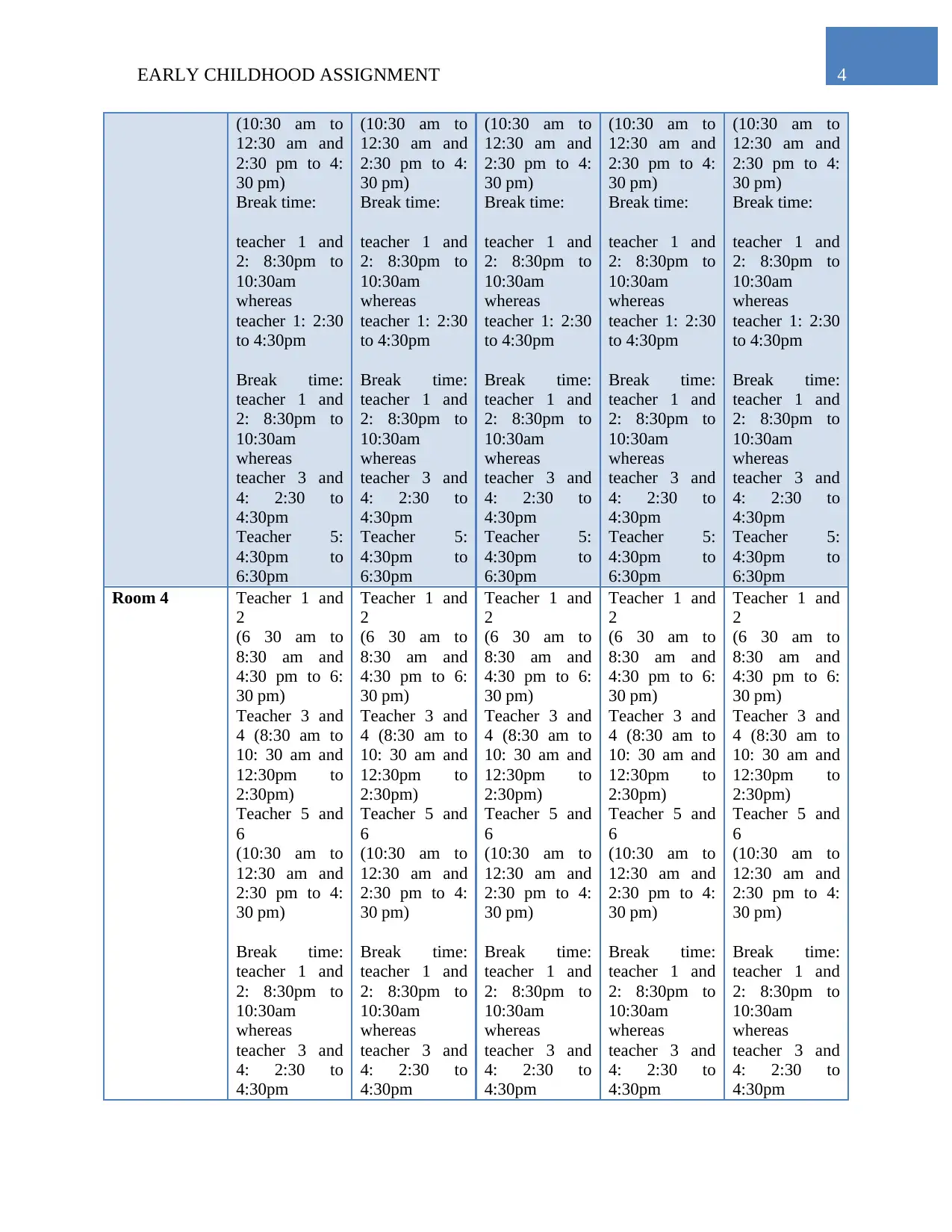
4EARLY CHILDHOOD ASSIGNMENT
(10:30 am to
12:30 am and
2:30 pm to 4:
30 pm)
Break time:
teacher 1 and
2: 8:30pm to
10:30am
whereas
teacher 1: 2:30
to 4:30pm
Break time:
teacher 1 and
2: 8:30pm to
10:30am
whereas
teacher 3 and
4: 2:30 to
4:30pm
Teacher 5:
4:30pm to
6:30pm
(10:30 am to
12:30 am and
2:30 pm to 4:
30 pm)
Break time:
teacher 1 and
2: 8:30pm to
10:30am
whereas
teacher 1: 2:30
to 4:30pm
Break time:
teacher 1 and
2: 8:30pm to
10:30am
whereas
teacher 3 and
4: 2:30 to
4:30pm
Teacher 5:
4:30pm to
6:30pm
(10:30 am to
12:30 am and
2:30 pm to 4:
30 pm)
Break time:
teacher 1 and
2: 8:30pm to
10:30am
whereas
teacher 1: 2:30
to 4:30pm
Break time:
teacher 1 and
2: 8:30pm to
10:30am
whereas
teacher 3 and
4: 2:30 to
4:30pm
Teacher 5:
4:30pm to
6:30pm
(10:30 am to
12:30 am and
2:30 pm to 4:
30 pm)
Break time:
teacher 1 and
2: 8:30pm to
10:30am
whereas
teacher 1: 2:30
to 4:30pm
Break time:
teacher 1 and
2: 8:30pm to
10:30am
whereas
teacher 3 and
4: 2:30 to
4:30pm
Teacher 5:
4:30pm to
6:30pm
(10:30 am to
12:30 am and
2:30 pm to 4:
30 pm)
Break time:
teacher 1 and
2: 8:30pm to
10:30am
whereas
teacher 1: 2:30
to 4:30pm
Break time:
teacher 1 and
2: 8:30pm to
10:30am
whereas
teacher 3 and
4: 2:30 to
4:30pm
Teacher 5:
4:30pm to
6:30pm
Room 4 Teacher 1 and
2
(6 30 am to
8:30 am and
4:30 pm to 6:
30 pm)
Teacher 3 and
4 (8:30 am to
10: 30 am and
12:30pm to
2:30pm)
Teacher 5 and
6
(10:30 am to
12:30 am and
2:30 pm to 4:
30 pm)
Break time:
teacher 1 and
2: 8:30pm to
10:30am
whereas
teacher 3 and
4: 2:30 to
4:30pm
Teacher 1 and
2
(6 30 am to
8:30 am and
4:30 pm to 6:
30 pm)
Teacher 3 and
4 (8:30 am to
10: 30 am and
12:30pm to
2:30pm)
Teacher 5 and
6
(10:30 am to
12:30 am and
2:30 pm to 4:
30 pm)
Break time:
teacher 1 and
2: 8:30pm to
10:30am
whereas
teacher 3 and
4: 2:30 to
4:30pm
Teacher 1 and
2
(6 30 am to
8:30 am and
4:30 pm to 6:
30 pm)
Teacher 3 and
4 (8:30 am to
10: 30 am and
12:30pm to
2:30pm)
Teacher 5 and
6
(10:30 am to
12:30 am and
2:30 pm to 4:
30 pm)
Break time:
teacher 1 and
2: 8:30pm to
10:30am
whereas
teacher 3 and
4: 2:30 to
4:30pm
Teacher 1 and
2
(6 30 am to
8:30 am and
4:30 pm to 6:
30 pm)
Teacher 3 and
4 (8:30 am to
10: 30 am and
12:30pm to
2:30pm)
Teacher 5 and
6
(10:30 am to
12:30 am and
2:30 pm to 4:
30 pm)
Break time:
teacher 1 and
2: 8:30pm to
10:30am
whereas
teacher 3 and
4: 2:30 to
4:30pm
Teacher 1 and
2
(6 30 am to
8:30 am and
4:30 pm to 6:
30 pm)
Teacher 3 and
4 (8:30 am to
10: 30 am and
12:30pm to
2:30pm)
Teacher 5 and
6
(10:30 am to
12:30 am and
2:30 pm to 4:
30 pm)
Break time:
teacher 1 and
2: 8:30pm to
10:30am
whereas
teacher 3 and
4: 2:30 to
4:30pm
(10:30 am to
12:30 am and
2:30 pm to 4:
30 pm)
Break time:
teacher 1 and
2: 8:30pm to
10:30am
whereas
teacher 1: 2:30
to 4:30pm
Break time:
teacher 1 and
2: 8:30pm to
10:30am
whereas
teacher 3 and
4: 2:30 to
4:30pm
Teacher 5:
4:30pm to
6:30pm
(10:30 am to
12:30 am and
2:30 pm to 4:
30 pm)
Break time:
teacher 1 and
2: 8:30pm to
10:30am
whereas
teacher 1: 2:30
to 4:30pm
Break time:
teacher 1 and
2: 8:30pm to
10:30am
whereas
teacher 3 and
4: 2:30 to
4:30pm
Teacher 5:
4:30pm to
6:30pm
(10:30 am to
12:30 am and
2:30 pm to 4:
30 pm)
Break time:
teacher 1 and
2: 8:30pm to
10:30am
whereas
teacher 1: 2:30
to 4:30pm
Break time:
teacher 1 and
2: 8:30pm to
10:30am
whereas
teacher 3 and
4: 2:30 to
4:30pm
Teacher 5:
4:30pm to
6:30pm
(10:30 am to
12:30 am and
2:30 pm to 4:
30 pm)
Break time:
teacher 1 and
2: 8:30pm to
10:30am
whereas
teacher 1: 2:30
to 4:30pm
Break time:
teacher 1 and
2: 8:30pm to
10:30am
whereas
teacher 3 and
4: 2:30 to
4:30pm
Teacher 5:
4:30pm to
6:30pm
(10:30 am to
12:30 am and
2:30 pm to 4:
30 pm)
Break time:
teacher 1 and
2: 8:30pm to
10:30am
whereas
teacher 1: 2:30
to 4:30pm
Break time:
teacher 1 and
2: 8:30pm to
10:30am
whereas
teacher 3 and
4: 2:30 to
4:30pm
Teacher 5:
4:30pm to
6:30pm
Room 4 Teacher 1 and
2
(6 30 am to
8:30 am and
4:30 pm to 6:
30 pm)
Teacher 3 and
4 (8:30 am to
10: 30 am and
12:30pm to
2:30pm)
Teacher 5 and
6
(10:30 am to
12:30 am and
2:30 pm to 4:
30 pm)
Break time:
teacher 1 and
2: 8:30pm to
10:30am
whereas
teacher 3 and
4: 2:30 to
4:30pm
Teacher 1 and
2
(6 30 am to
8:30 am and
4:30 pm to 6:
30 pm)
Teacher 3 and
4 (8:30 am to
10: 30 am and
12:30pm to
2:30pm)
Teacher 5 and
6
(10:30 am to
12:30 am and
2:30 pm to 4:
30 pm)
Break time:
teacher 1 and
2: 8:30pm to
10:30am
whereas
teacher 3 and
4: 2:30 to
4:30pm
Teacher 1 and
2
(6 30 am to
8:30 am and
4:30 pm to 6:
30 pm)
Teacher 3 and
4 (8:30 am to
10: 30 am and
12:30pm to
2:30pm)
Teacher 5 and
6
(10:30 am to
12:30 am and
2:30 pm to 4:
30 pm)
Break time:
teacher 1 and
2: 8:30pm to
10:30am
whereas
teacher 3 and
4: 2:30 to
4:30pm
Teacher 1 and
2
(6 30 am to
8:30 am and
4:30 pm to 6:
30 pm)
Teacher 3 and
4 (8:30 am to
10: 30 am and
12:30pm to
2:30pm)
Teacher 5 and
6
(10:30 am to
12:30 am and
2:30 pm to 4:
30 pm)
Break time:
teacher 1 and
2: 8:30pm to
10:30am
whereas
teacher 3 and
4: 2:30 to
4:30pm
Teacher 1 and
2
(6 30 am to
8:30 am and
4:30 pm to 6:
30 pm)
Teacher 3 and
4 (8:30 am to
10: 30 am and
12:30pm to
2:30pm)
Teacher 5 and
6
(10:30 am to
12:30 am and
2:30 pm to 4:
30 pm)
Break time:
teacher 1 and
2: 8:30pm to
10:30am
whereas
teacher 3 and
4: 2:30 to
4:30pm
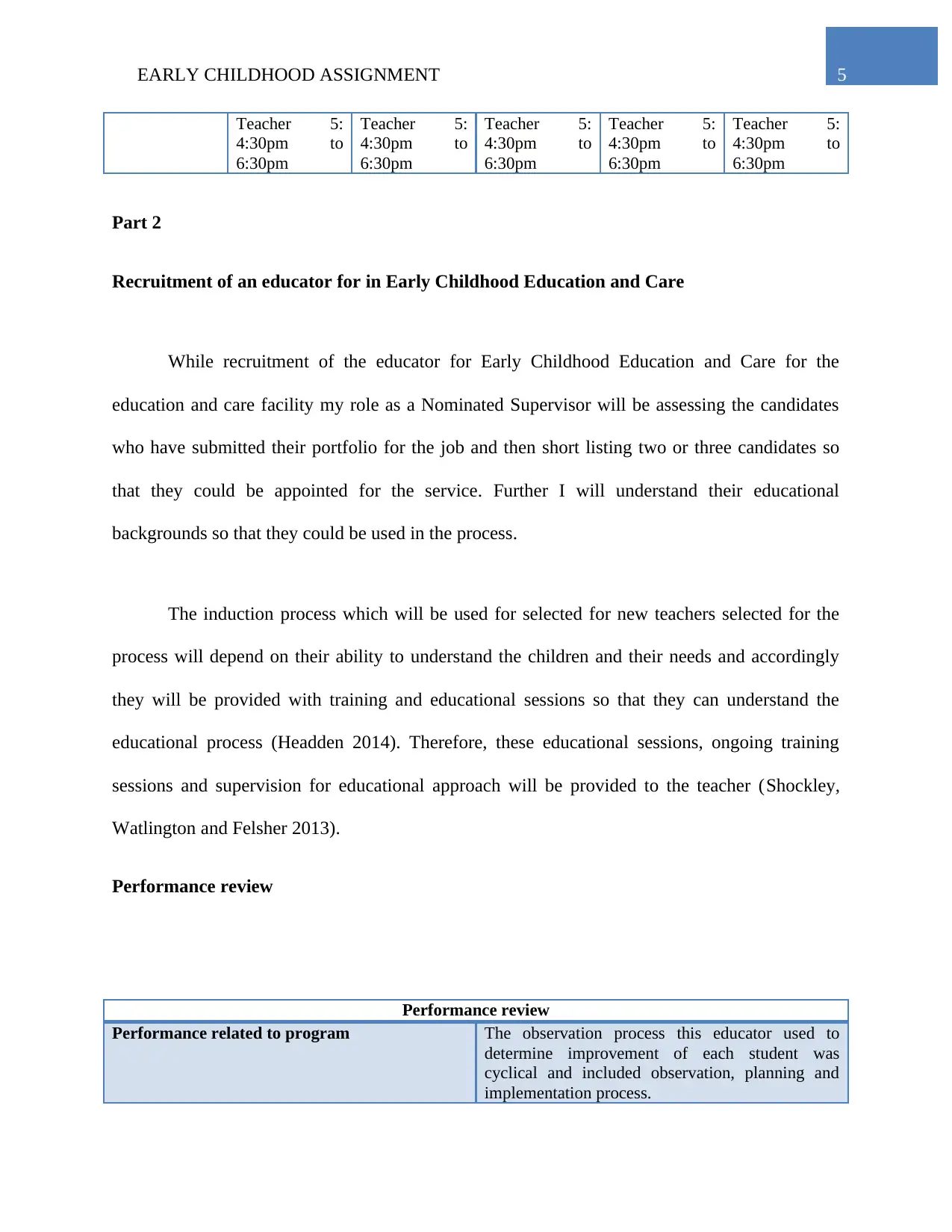
5EARLY CHILDHOOD ASSIGNMENT
Teacher 5:
4:30pm to
6:30pm
Teacher 5:
4:30pm to
6:30pm
Teacher 5:
4:30pm to
6:30pm
Teacher 5:
4:30pm to
6:30pm
Teacher 5:
4:30pm to
6:30pm
Part 2
Recruitment of an educator for in Early Childhood Education and Care
While recruitment of the educator for Early Childhood Education and Care for the
education and care facility my role as a Nominated Supervisor will be assessing the candidates
who have submitted their portfolio for the job and then short listing two or three candidates so
that they could be appointed for the service. Further I will understand their educational
backgrounds so that they could be used in the process.
The induction process which will be used for selected for new teachers selected for the
process will depend on their ability to understand the children and their needs and accordingly
they will be provided with training and educational sessions so that they can understand the
educational process (Headden 2014). Therefore, these educational sessions, ongoing training
sessions and supervision for educational approach will be provided to the teacher (Shockley,
Watlington and Felsher 2013).
Performance review
Performance review
Performance related to program The observation process this educator used to
determine improvement of each student was
cyclical and included observation, planning and
implementation process.
Teacher 5:
4:30pm to
6:30pm
Teacher 5:
4:30pm to
6:30pm
Teacher 5:
4:30pm to
6:30pm
Teacher 5:
4:30pm to
6:30pm
Teacher 5:
4:30pm to
6:30pm
Part 2
Recruitment of an educator for in Early Childhood Education and Care
While recruitment of the educator for Early Childhood Education and Care for the
education and care facility my role as a Nominated Supervisor will be assessing the candidates
who have submitted their portfolio for the job and then short listing two or three candidates so
that they could be appointed for the service. Further I will understand their educational
backgrounds so that they could be used in the process.
The induction process which will be used for selected for new teachers selected for the
process will depend on their ability to understand the children and their needs and accordingly
they will be provided with training and educational sessions so that they can understand the
educational process (Headden 2014). Therefore, these educational sessions, ongoing training
sessions and supervision for educational approach will be provided to the teacher (Shockley,
Watlington and Felsher 2013).
Performance review
Performance review
Performance related to program The observation process this educator used to
determine improvement of each student was
cyclical and included observation, planning and
implementation process.
⊘ This is a preview!⊘
Do you want full access?
Subscribe today to unlock all pages.

Trusted by 1+ million students worldwide
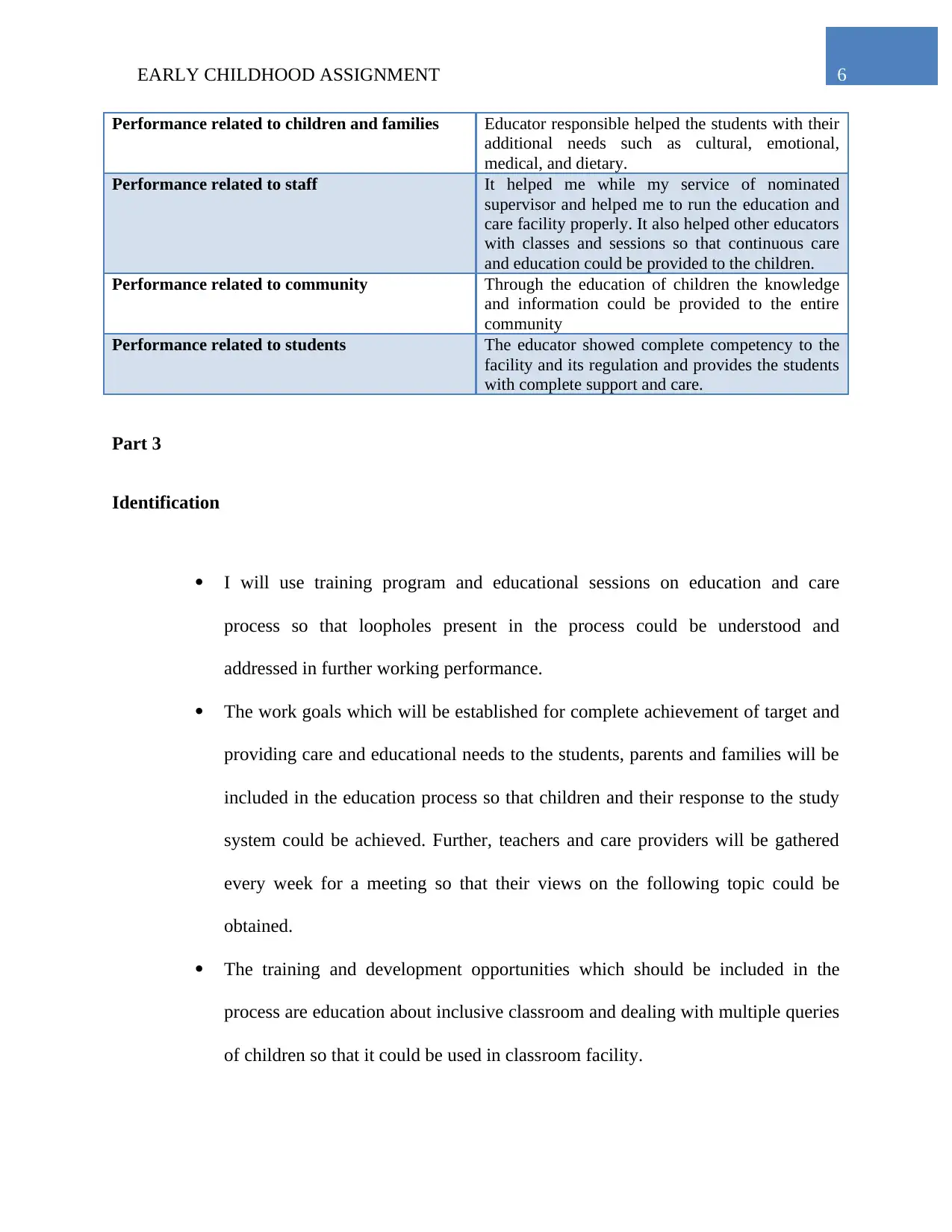
6EARLY CHILDHOOD ASSIGNMENT
Performance related to children and families Educator responsible helped the students with their
additional needs such as cultural, emotional,
medical, and dietary.
Performance related to staff It helped me while my service of nominated
supervisor and helped me to run the education and
care facility properly. It also helped other educators
with classes and sessions so that continuous care
and education could be provided to the children.
Performance related to community Through the education of children the knowledge
and information could be provided to the entire
community
Performance related to students The educator showed complete competency to the
facility and its regulation and provides the students
with complete support and care.
Part 3
Identification
I will use training program and educational sessions on education and care
process so that loopholes present in the process could be understood and
addressed in further working performance.
The work goals which will be established for complete achievement of target and
providing care and educational needs to the students, parents and families will be
included in the education process so that children and their response to the study
system could be achieved. Further, teachers and care providers will be gathered
every week for a meeting so that their views on the following topic could be
obtained.
The training and development opportunities which should be included in the
process are education about inclusive classroom and dealing with multiple queries
of children so that it could be used in classroom facility.
Performance related to children and families Educator responsible helped the students with their
additional needs such as cultural, emotional,
medical, and dietary.
Performance related to staff It helped me while my service of nominated
supervisor and helped me to run the education and
care facility properly. It also helped other educators
with classes and sessions so that continuous care
and education could be provided to the children.
Performance related to community Through the education of children the knowledge
and information could be provided to the entire
community
Performance related to students The educator showed complete competency to the
facility and its regulation and provides the students
with complete support and care.
Part 3
Identification
I will use training program and educational sessions on education and care
process so that loopholes present in the process could be understood and
addressed in further working performance.
The work goals which will be established for complete achievement of target and
providing care and educational needs to the students, parents and families will be
included in the education process so that children and their response to the study
system could be achieved. Further, teachers and care providers will be gathered
every week for a meeting so that their views on the following topic could be
obtained.
The training and development opportunities which should be included in the
process are education about inclusive classroom and dealing with multiple queries
of children so that it could be used in classroom facility.
Paraphrase This Document
Need a fresh take? Get an instant paraphrase of this document with our AI Paraphraser

7EARLY CHILDHOOD ASSIGNMENT
As per the principles of coaching, the education and care facility should be safe
and secure however should be inclusive of a challenging environment so that
children could deal with such challenges. Further, I will comply with the
educational centres agenda so that quality education and care could be provided.
Further the process will have quality of facilitation an collaboration and will
advocate self awareness (Jones and Bouffard 2012).
The additional support or instructions which would be require for this process are
help from the local government and communities so that healthcare could be
implemented.
The first strategy which will be used in this case is addressing the issue privately
so that the system could not be affected. The second strategy which will be used is
the communication medium so that dealing with the process could become easier
(Moore 2014).
As per the principles of coaching, the education and care facility should be safe
and secure however should be inclusive of a challenging environment so that
children could deal with such challenges. Further, I will comply with the
educational centres agenda so that quality education and care could be provided.
Further the process will have quality of facilitation an collaboration and will
advocate self awareness (Jones and Bouffard 2012).
The additional support or instructions which would be require for this process are
help from the local government and communities so that healthcare could be
implemented.
The first strategy which will be used in this case is addressing the issue privately
so that the system could not be affected. The second strategy which will be used is
the communication medium so that dealing with the process could become easier
(Moore 2014).
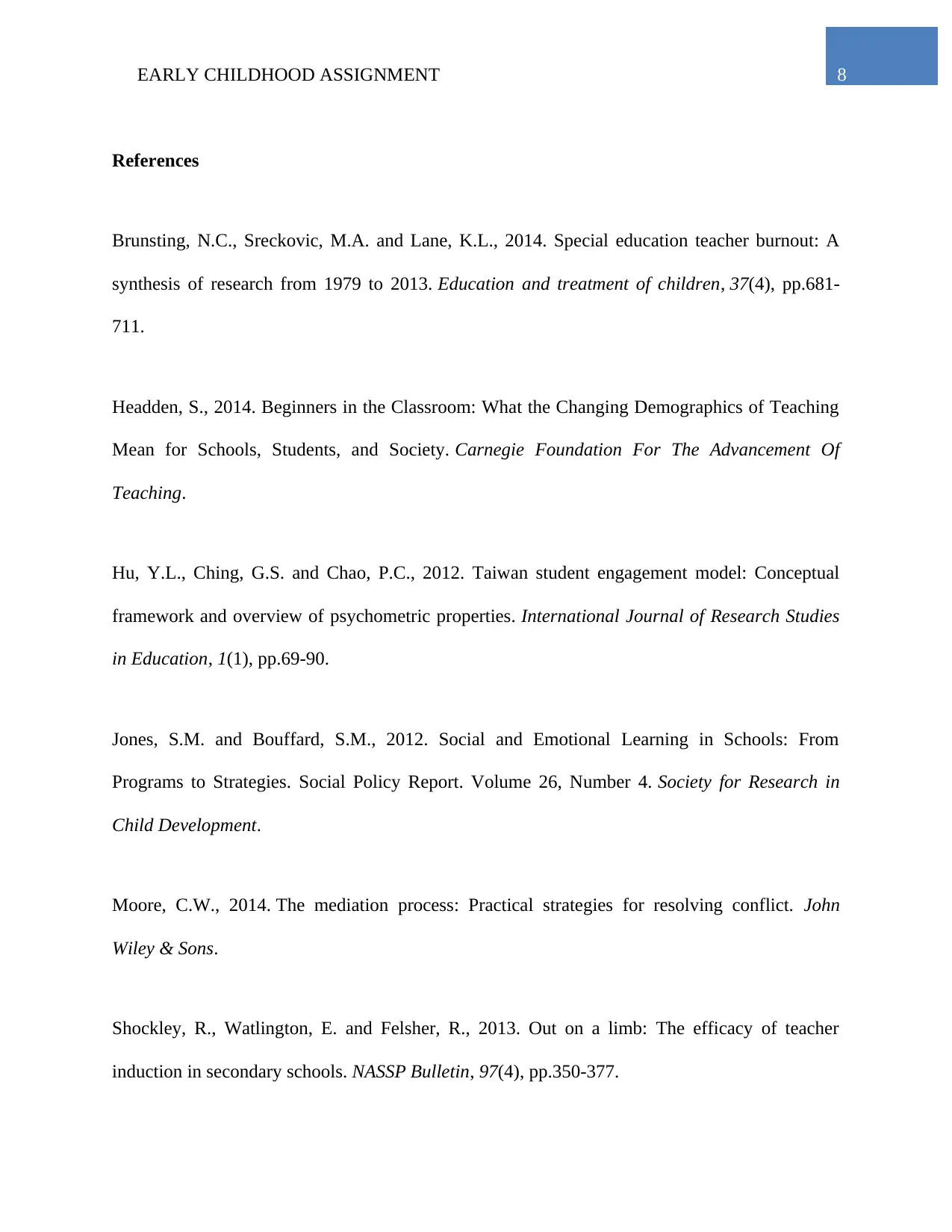
8EARLY CHILDHOOD ASSIGNMENT
References
Brunsting, N.C., Sreckovic, M.A. and Lane, K.L., 2014. Special education teacher burnout: A
synthesis of research from 1979 to 2013. Education and treatment of children, 37(4), pp.681-
711.
Headden, S., 2014. Beginners in the Classroom: What the Changing Demographics of Teaching
Mean for Schools, Students, and Society. Carnegie Foundation For The Advancement Of
Teaching.
Hu, Y.L., Ching, G.S. and Chao, P.C., 2012. Taiwan student engagement model: Conceptual
framework and overview of psychometric properties. International Journal of Research Studies
in Education, 1(1), pp.69-90.
Jones, S.M. and Bouffard, S.M., 2012. Social and Emotional Learning in Schools: From
Programs to Strategies. Social Policy Report. Volume 26, Number 4. Society for Research in
Child Development.
Moore, C.W., 2014. The mediation process: Practical strategies for resolving conflict. John
Wiley & Sons.
Shockley, R., Watlington, E. and Felsher, R., 2013. Out on a limb: The efficacy of teacher
induction in secondary schools. NASSP Bulletin, 97(4), pp.350-377.
References
Brunsting, N.C., Sreckovic, M.A. and Lane, K.L., 2014. Special education teacher burnout: A
synthesis of research from 1979 to 2013. Education and treatment of children, 37(4), pp.681-
711.
Headden, S., 2014. Beginners in the Classroom: What the Changing Demographics of Teaching
Mean for Schools, Students, and Society. Carnegie Foundation For The Advancement Of
Teaching.
Hu, Y.L., Ching, G.S. and Chao, P.C., 2012. Taiwan student engagement model: Conceptual
framework and overview of psychometric properties. International Journal of Research Studies
in Education, 1(1), pp.69-90.
Jones, S.M. and Bouffard, S.M., 2012. Social and Emotional Learning in Schools: From
Programs to Strategies. Social Policy Report. Volume 26, Number 4. Society for Research in
Child Development.
Moore, C.W., 2014. The mediation process: Practical strategies for resolving conflict. John
Wiley & Sons.
Shockley, R., Watlington, E. and Felsher, R., 2013. Out on a limb: The efficacy of teacher
induction in secondary schools. NASSP Bulletin, 97(4), pp.350-377.
⊘ This is a preview!⊘
Do you want full access?
Subscribe today to unlock all pages.

Trusted by 1+ million students worldwide
1 out of 9
Related Documents
Your All-in-One AI-Powered Toolkit for Academic Success.
+13062052269
info@desklib.com
Available 24*7 on WhatsApp / Email
![[object Object]](/_next/static/media/star-bottom.7253800d.svg)
Unlock your academic potential
Copyright © 2020–2025 A2Z Services. All Rights Reserved. Developed and managed by ZUCOL.





